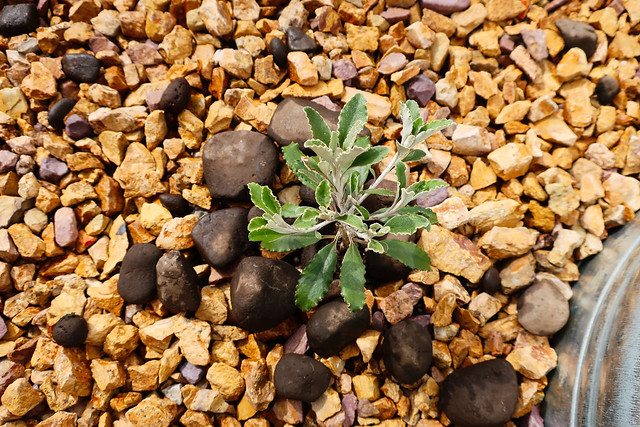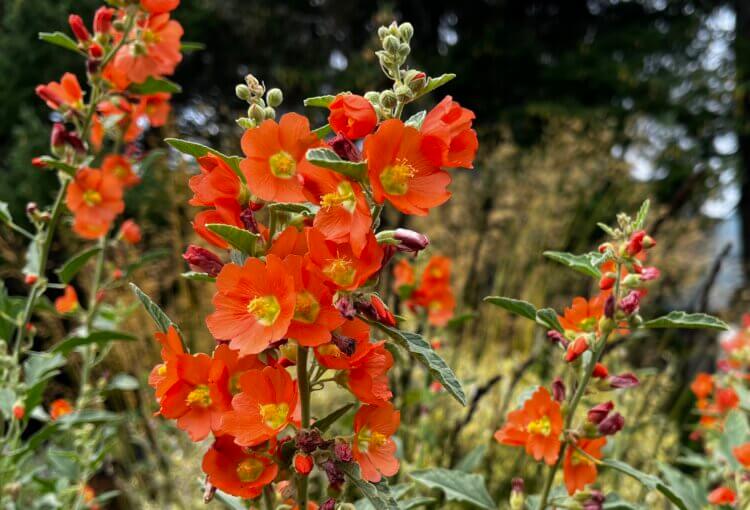December temps have been in the 80’sF, astonishing even to this lifelong Angeleno. Fairly quickly I’ve re-adapted to the prevailing attitude that keeping track of the weather is mostly irrelevant here. I left checking hourly weather forecasts behind in Oregon with my mud boots. The outdoor temp gauge here gives enough rough data as in, wow, is it really over 80F today? I have to admit my old bones appreciate the warmth, and my busy nervous system thrives on busy mornings in the garden. The more tedious the task, the better for slowing time. Just cleaning up the bromeliads has taken countless focused, very zen hours.
Cleaning up the Yucca rostrata, its very first thorough grooming, reduced the fractious world to absorbing fractals for a few blessed hours.. There was a 3-4 inch collar of acacia debris clogging the trunk in a circular vise that kept the trunk moist, which can’t be good, and the cascading skirt of dried lower leaves acted as a dam preventing debris from escaping. (Yes, there’s now a 2-foot, very slow-growing trunk!). Hemostats, hori-hori knife, scissors, battery-operated hedge trimmers and sharp blasts from the hose — every tool on hand was brought to the task. Mostly I used my hands, which two days later are slightly less sore. Please don’t tell me that all that debris is actually essential to the yucca’s health. At this point, I’d rather not know.
It was clearing and unearthing the rock path that provided the needed access to tackle cleaning the yucca. I’m experimenting with using decomposed granite as a mulch to keep down weeds along the rocks, approx 3 inches deep. There’s already a lot of gravel here, and there is a bed of sand too from a former dry-laid brick patio, so it’s almost like a base for the d.g. was prepped beforehand. So far the carpets of couch grass seedlings that return everywhere else have not made a reappearance.
The d.g. was mainly kept to the rocked area. Weed trap Agave ‘Mateo’ got some of it, and I may add more d.g. around the more permanent plantings if this gambit works. The spreading clump of Hechtia tillandsioides suppresses the weeds beautifully, and I want more but haven’t figured out its propagation preferences yet. I may have to disturb that flourishing clump for divisions.
Familiarizing myself with local plant offerings continues. At an Orange County destination nursery once famous for an adventurous plant selection, now more famous for its restaurant and holiday decor collection, I unexpectedly found an aloe with an intriguing name ‘Tingtinkie.’ Hmmm, sounds South African, possibly from one of the great aloe growers like Sunbird Aloes. Reflexively, as I’ve done countless times while plant shopping, I tapped into the phone and was taken, of course, to the San Marcos Growers encyclopedic website, where I found this comprehensive physical description as well as how SMG came to know and grow this little aloe. You know, just another typically erudite SMG entry. Where did Randy Baldwin find the time?! In fact, every plant I’ve mentioned in this post, including Hechtia tillandsioides, the crinum, Kalanchoe ‘John Bleck, and Agave attenuata ‘Kara’s Stripes,’ can be found in SMG’s online database.
“Aloe ‘Tingtinkie’ A small hybrid aloe that forms a mound of 12 inch wide rosettes bearing 7 inch long slender green slightly recurved leaves with evenly space teeth along their margins. Through much of the year appear the upright inflorescences to 18 inches tall, that are quite sturdy given the relatively diminutive habit of the plant, and bear a large terminal cluster of flowers that are a dark coral pink in bud and open to a cream color tipped with green. The buds are at first erect then horizontal with the flowers opening from the bottom up holding themselves downward – very showy! Plant in full sun to light shade in a well-drained soil and irrigate occasionally to infrequently. This plant forms a cheery cluster of foliage and seems to be in bloom much of the year. We first saw this plant growing at Ganna Walska Lotusland in 2006 simply tagged “Aloe sp. 2006-024”. Lotusland’s accession records indicated that the plant came to them from Abbey Gardens Nursery as a Cynthia Giddy hybrid aloe (AbG 75-220) – Cynthia Giddy was a well-known South African conservationist, horticulturist who maintained Umlaas Nursery in Natal, South Africa. We also grow the very popular aloes, Aloe ‘Cynthia Giddy’ and Aloe ‘Rooikappie’ that came from this nursery. In 2015 The Huntington Botanic Garden released this plant through their International Succulent Introduction (ISI) program as Aloe ‘Tingtinkie’ (ISI 2015-18) (HBG 32505), confirming it was a Cynthia Giddy hybrid that came from her Umlaas Aloe Nursery in 1973, with speculation that it likely involved Aloe bakeri crossed with some other larger flowering aloe (possibly A. cryptopoda) and that the name was thought to be a term of endearment for a “dinky thing”, in reference to the dwarf stature of the plant in comparison to its relatively large flowers. We do have a comparison plant from the ISI release but our plants in production are all from plants won at auction the Lotusland Exception Plant Auction. — San Marcos Growers
Goodbye to the patron saint of West Coast gardens! After 45 years, San Marcos Growers shuts down January 2026, but the website/resource library will endure. The aloe description provides clues to the amazing synergy of growers and gardens that surrounded SMG — Lotusland, Huntington Botanic Gardens. For more on SMG, check out this video, which bobs and weaves through a who’s who of West Coast horticulture, Brian Kemble of Ruth Bancroft Garden, Jo O’Connell, Flora Grubb, John Greenlee. (At about 17 minutes Jeff Chemnick of Aloes in Wonderland gives a wonderful presentation on what makes the Central Coast so special for growing and gardens.)
A scape of the giant red crinum, aka Queen Emma’s Purple Crinum, has been opening this week.
And a spasm of scented blossom from the Acacia podalyrifolia fills the front garden with notes of anise.
Enjoy the holidays — or not! Take care, mind how you go. Best, AGO




























































































































